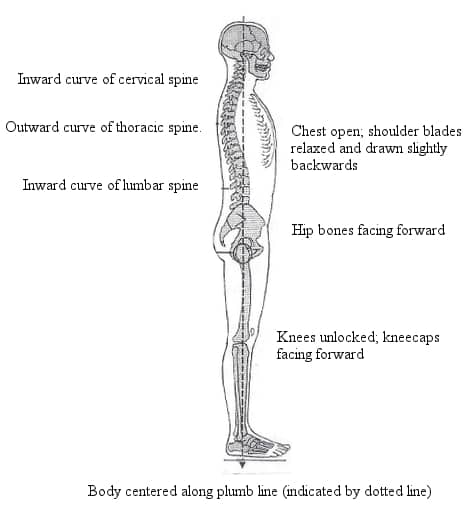In this month’s blog post, we’ll be continuing our Posture and Movement series with a look at neutral joint alignment.
Chances are, if you’ve ever been a patient at APT, you’ve heard us talk about neutral alignment. After all, it’s pretty much the basis of everything we do here! So we want to make sure that you have the resources you need to build your foundation—both in body and in mind.
Let’s get started with a quick review. Neutral joint alignment is the body’s bio mechanically-correct alignment. When we are in neutral alignment, we are in the position in which there is the least amount of stress on our joints. In the short term, this can prevent or alleviate discomfort. In the long term, consistently maintaining a neutral position will help to keep your body functioning well over time.
Below is an image demonstrating what neutral alignment looks like. In this illustration, the body is centered around a plumb line that runs vertically through the ears, shoulders, hips, knees and ankles. When trying to find neutral alignment, it can be helpful to imagine this plumb line.

So let’s practice finding neutral while standing. The Mountain pose, a foundational pose in Yoga, is a great example of neutral alignment. Use the following cues to access Mountain pose:
- Stand with your feet hip-width apart.
- Allow your arms to rest at your sides with your elbow creases facing forwards.
- Keep your entire body lengthened towards the sky as you ground your feet into the earth.
- Engage your transversus abdominis by drawing your navel gently towards your spine.
- Notice and relax any muscles that are holding tension.
- Tuck your chin slightly and gaze forward.
- Breathe slowly and deeply.
- To see if you are centered and balanced, sway back and forth until your weight is centered over the middle of your feet.
Below, Catherine stands in Mountain pose, demonstrating her body’s best neutral alignment.

Remember, optimal posture is based on your specific anatomy, strength and flexibility. Do not force, overtighten or “grip” any of your muscles; instead, allow yourself to be supported by the deep postural muscles as they work at a low hum in the background.
Neutral alignment is the foundation of good posture and joint preservation. It might seem like a daunting task now, but if you think of it as the home base that you come back to whenever you have a chance, your body will thank you for it!
Next month, we’ll go over lower body posture. If you missed last month’s post on upper body posture, you can check it out here.

Comments